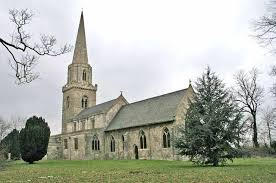History of Brayton
Brayton or 'Breide-tun' was first mentioned in a Saxon time document dated 1030. It was later mentioned as 'Bretone' in the Domesday Book in 1076. By 1775 documents had the name of Brayton entered.
There is only one Brayton in Britain, with four in the USA and one in Canada.
From past census figures a large growth can be seen in Brayton:
1801 - 227
1931 - 485
1961 - 1061
1981 - 3380
2004 - 5000
Part of the explanation may be that we are so close to the market town of Selby, but the building of Eggborough and Drax Power Stations in the 1970's brought many new properties to the area. The Selby Coal Field, approved in 1976, also increased the population.
Proximity to the M62 for travel to Leeds and Hull, and being on the A19 for Doncaster and York all make Brayton an attractive place to live. Over 2000 children attend the four local Primary schools and College in the Parish.
 St Wilfrids Church
St Wilfrids Church
Although there are no known remains of an earlier church than our St Wilfrids, we are sure there would have been a Saxon Church here, attached to the Manor, and probably built of wood. William the Conqueror granted land in Brayton to Selby Abbey soon after the Conquest, and the affairs of Brayton Church were closely linked with the Abbey up to the dissolution in 1539. The oldest parts of the church were probably built by the Abbot of Selby around 1100.
The original building would have comprised:
The present West Tower (without either the Octagon or the spire – both added in the 15th century)A Nave and the present South Door – the Nave was almost totally rebuilt in the 14th century. The original Nave was much the same length but without the side aisles.A Chancel and Sanctuary – much shorter than the present buildings, which were almost totally rebuilt in the 14th century.The present most interesting features of St Wilfrids include:
South Doorway – Norman Archway Triple Columns and three orders of decoration.Chancel – fine Norman Arch and Capitals. 14th century four-light East Window.Tomb of George D'Arcy – dated 1558First World War Memorial.The Methodist Chapel

Braytons first link with Methodism is recorded on an old chair in the Chapel 'Used on his preaching at Brayton by John Wesley' it is thought to date between 1759 and 1790.
In 1844 William Staniland, of Brayton House, gave a corner of his garden for the building of a chapel or meeting house – this is still in use today.
In the 1950's – coinciding with the growth of Brayton – a Sunday School and Youth Club were formed. In 1961 the single room chapel was extended to accommodate this Youth Work. Further rebuilding was completed in 1994 and opened in time for the 150th Anniversary.
Brayton Village Green
The green is located in front of Brayton Infants and Primary School.
On a map dating back to 1892 the green had two levels, the lower level dropping down to a pond. The School (now Infants School) and School House were built in 1872.
On Christmas Eve 1918 a single Horse Chestnut tree was planted in the School playground in honour of the Boys of Brayton who died in the Great War. On 19th December 1919 twelve more Chestnut trees were planted around the Green as a Memorial to all those in Brayton Village who died in the Great War. Some of these trees have had to be replaced and one was lost when the Traffic Lights were installed.
The Pond was used less and less and eventually filled and the Green levelled in the early 1960's.
B rayton Barff
rayton Barff
Brayton Barff is the high point of the area – standing some 150 feet above sea level. It was the site of a beacon in 1803 when we were threatened with invasion by Napoleon.
In May 1935, to celebrate King George V's Silver Jubilee, a Bonfire was lit on the Barff as part of the celebrations. In both World Wars much use was made of the various Camps on the Barff and they housed Prisoners of War in WW2.
It is now owned by Yorkshire Water, who have provided a car park on the Barff Lane side of the Barff, and is well used by walkers and bird watchers.
Text extracted from 'Breide-Tun 1030 to Brayton 2000' compiled by Ron Ellis.

